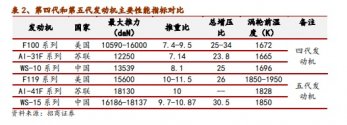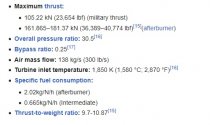The cult of WS-15I desperately need them to put up a WS-15 display in next year’s Zhuhai. I will go in person and erect an alter of worship at its face (and maybe sacrifice a chicken is the ways of old)
You are using an out of date browser. It may not display this or other websites correctly.
You should upgrade or use an alternative browser.
You should upgrade or use an alternative browser.
J-20 5th Generation Fighter VII
- Thread starter siegecrossbow
- Start date
- Status
- Not open for further replies.
F135 is way more advanced than F119. The main metric used to distinguish engine generations is the turbine inlet temperature. Inlet temperature is 1922K in the F119 and 2260K in the F135. For comparison it is 1623K in the F100 engine used in the F-16 and F-15.I don't think they are directly comparable. And I think it's a common misunderstanding to say F135 is better than F119. F135 has a BPR of 0.57, while F119 is 0.3, of course it is easier for F135 to have larger Thrust and Thrust-to-weight ratio.
F135 also has higher thrust to weight ratio than F119. It is just more advanced in general. Period.
The F-35 cannot supercruise properly for several reasons and one of them is the airframe. It has extremely wide frontal area, composites which melt at high friction temperatures, and fixed inlets, so you cannot just blame this on the engine BPR.WS-15's BPR is only 0.25. WS-15 and F119 are more similar.
From my understanding. F35 doesn't have great Supercruise capability with F135 due to such a big BPR.
The F-35 has just crap aerodynamics in general and is not designed for speed at all. The Saab Viggen had an engine BPR of 0.97. It reached Mach 2.1. The F-35 cannot go over Mach 1.6.
If it is true that the WS-15 has a turbine inlet temperature of 1841K that is a major step forward for Chinese engines. Russian AL-41F1 has a turbine inlet temperature of 1745K for example.
Unconfirmed rumors
The cockpit back block is been using adding some state-of-art AI equipment.
The cockpit back block is been using adding some state-of-art AI equipment.
Did we ever get a takeoff distance and angle analysis on the forums here? Angle seems to be pretty steep.
I don't see how the composite material is a barrier to supercruising when it can go Mach 1.6.F135 is way more advanced than F119. The main metric used to distinguish engine generations is the turbine inlet temperature. Inlet temperature is 1922K in the F119 and 2260K in the F135. For comparison it is 1623K in the F100 engine used in the F-16 and F-15.
F135 also has higher thrust to weight ratio than F119. It is just more advanced in general. Period.
The F-35 cannot supercruise properly for several reasons and one of them is the airframe. It has extremely wide frontal area, composites which melt at high friction temperatures, and fixed inlets, so you cannot just blame this on the engine BPR.
The F-35 has just crap aerodynamics in general and is not designed for speed at all. The Saab Viggen had an engine BPR of 0.97. It reached Mach 2.1. The F-35 cannot go over Mach 1.6.
If it is true that the WS-15 has a turbine inlet temperature of 1841K that is a major step forward for Chinese engines. Russian AL-41F1 has a turbine inlet temperature of 1745K for example.
Unconfirmed rumors
The cockpit back block is been using adding some state-of-art AI equipment.
It’s R2-D2ing time!
i don't want to speculate.If it is true that the WS-15 has a turbine inlet temperature of 1841K that is a major step forward for Chinese engines. Russian AL-41F1 has a turbine inlet temperature of 1745K for example.
so WS-15 inlet turbine temperature is less than F-119, a 3 decades old engine if we talk about development timeline. no its not.
M88 engine has 1850k ITT
EJ200 engine has 1800k ITT
in 2017 cmschina a Hongkong based security firm publish the magazine about China aero engine industry and prediction. in which they interviewed some of China's local defense experts. and publish the data about various Chinese engine.
WS-15 inlet turbine temperature is 1850k according to them. as per 2017

this is how western internet got WS-15 specification. Wiki copied from this magazine. Wiki also copied their thrust to weight ratio. LOOL
screenshot of Wikipedia.

in 2018, Liming scrapped the old design of WS-15 and new WS-15 has emerged. all pre-2018 information are just outdated or false. cmschina is just a finance related website. they have zero credibility.
latest WS-15 inlet turbine temperature is more than 1850k. will be surprise for all of us after official announcement. i hope Liming officially release the specifications of WS-15. this is the right time to tell, how far China has come in aero engine technology.
Last edited:
FriedRiceNSpice
Major
Maximum attainable speed and maximum sustainable speed is different. Heat from friction increases over time, and materials also take time to degrade and break down, not instantaneously. Maximum speed for most aircraft will cause significant damage to aircraft that will necessitate significant repairs. Mig-25s that reach their top speed would suffer damage to the point of being beyond repair.I don't see how the composite material is a barrier to supercruising when it can go Mach 1.6.
Er not quite. Cycle design is the main metric used to distinguish engine generations. Engine advances are primarily driven by compressor power and efficiencies. The F135 mostly uses the same core cycle design as the F119, just with a larger fan section and thus an increased bypass ratio. It’s not a coincidence that the F-135’s margin of thrust increase relative to the F119 scaled very linearly with the increase in bypass ratio. The F135 does use more advanced materials for sure and that allows it to run a higher TIT, which helps improve the turbine efficiency, but insofar as basic cycle design is concerned it’s actually not innovating much relative to the F119. Slap a larger fan onto a vanilla F119 and you’re getting 90% of the way there.F135 is way more advanced than F119. The main metric used to distinguish engine generations is the turbine inlet temperature. Inlet temperature is 1922K in the F119 and 2260K in the F135. For comparison it is 1623K in the F100 engine used in the F-16 and F-15.
F135 also has higher thrust to weight ratio than F119. It is just more advanced in general. Period.
TIT itself can’t tell us much without other information because you can choose to use the exact same materials and go with a lower TIT and then bank in improved longevity on components. In fact, depending on TIT increases to drive thrust increases is usually indicative of a less advanced cycle design. More advanced cycle designs can get more thrust without having to run the engine as hot or hard. The ultimate mechanical goal of an engine after all is total force from the mass flow. That’s quantity of air * acceleration. Quantity of air is fixed by the fan diameter, so most of the rest of the engine is mechanically or thermally working to boost gas velocity. If you can impart greater gas velocity mechanically you don’t need to do that by increasing turbine temperature. TIT just isn’t the tell all for level of advancement you’re making it into.
Stick the F135 engine into a supersonic optimized airframe and it may still not supercruise very well. Larger fan diameter means more drag the engine has to fight to put work into the air stream at transonic and supersonic speeds.The F-35 cannot supercruise properly for several reasons and one of them is the airframe. It has extremely wide frontal area, composites which melt at high friction temperatures, and fixed inlets, so you cannot just blame this on the engine BPR.
The F-35 has just crap aerodynamics in general and is not designed for speed at all. The Saab Viggen had an engine BPR of 0.97. It reached Mach 2.1. The F-35 cannot go over Mach 1.6.
Also please don’t confuse supersonic top speed and supercruise. The former doesn’t tell you whether your engine can generate effective thrust without reheat at supersonic speed.
*IF* the numbers we are getting are correct, that the WS-15 has a dry thrust of 110 kN and a wet thrust of 170-190 kN with a BPR of only 0.25 and a TIT of "only" 1841, that may be more suggestive of how mechanically efficient this engine is rather than indicative of what TITs they are capable of. If you can get the same thrust performance running the engine cooler you don't need to run it hotter to hit design spec and can bank in those gains on other parameters like mainteinance life, no matter what your materials are capable of.If it is true that the WS-15 has a turbine inlet temperature of 1841K that is a major step forward for Chinese engines. Russian AL-41F1 has a turbine inlet temperature of 1745K for example.
Last edited:
*Maybe*. If the actual TIT is higher it would be more consistent with the performance of other engines of the same generation in its thrust class. But it is also possible, though maybe not plausible, that they really are able to get similar thrust performances at a lower TIT with a better cycle design. Too many details we just don't know.latest WS-15 inlet turbine temperature is more than 1850k. will be surprise for all of us after official announcement. i hope Liming officially release the specifications of WS-15. this is the right time to tell, how far China has come in aero engine technology.
- Status
- Not open for further replies.
